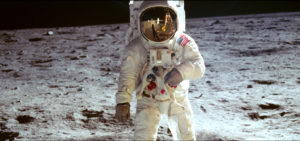
Brilliantly Realized, Stunningly Gorgeous “Apollo 11” Soars
“Apollo 11” is a visual delicacy to be savored long after the extensive credits roll—unlike most documentaries where talking head interviews and newspaper clippings are the main source—director/editor Todd Douglas Miller choose 50-year-old footage to tell the historic tale, along with original audio. And yes, the iconic flag-planting scene plays out in full detail.
Refreshing, exhilarating and mind-blowing are words that have semblance while viewing the tightly edited historically accurate film. Yet, this is the ‘real deal’ the July 16, 1969 moon launch through landing, and welcome back home on July 24—not a fantasy or a science fiction tale, and the best part, it’s astonishing! I’m here to tell you, I had chills while watching at my local IMAX theater, by using solely 70mm film footage that imprints details and light on a grander scale, it’s as if you see a new account like no other. Yes, it’s familiar to us all, in pieces, here you have the entire account that includes all three of the astronauts; Neil Armstrong, Buzz Aldrin, and Michael Collins.

Early beginnings are audio from NASA engineers, the astronauts themselves and clips of news reporter Walter Cronkite’s commentary the morning in Cape Canaveral, Florida. From the get-go, most noticeably is the sizeable work-force that’s in play surrounding the launch. With over-head shots panning the control center, clearly here is one area that’s never been accurately re-created in space films—no film has even come close to the magnitude of the people at both NASA in Florida and NASA Mission Control Center in Houston, TX.
As the astronauts are being driven to the launch site via transfer van the time merely appears displayed at the bottom of the screen as it would have looked 50 years ago, 6:27 am EDT, (Eastern Daylight Time). The coastline beach footage of the sunglassed families waiting for the launch is a rare sight; as usual, crowds that stare into the sky of this size are shown at night after sunset awaiting fireworks. Endangerment threatens during the van transport as NASA scientists discuss a leak in a valve containing liquid hydrogen, bolts are ordered tightened so that the 6.5 million pounds of spacecraft will be launch safely into space.

Speaking of the actual launch—the count down is heard loud and clear with the addition of a continuous beating heart, and a thunderous ear-piercing explosion—the seats of the IMAX actually began to shake. Clearly surpassing all previous Apollo 11 lift-off videos or films that I’ve ever seen to date. Talk about excitement; yep there were chills.
As the Green Team flight directors take over, NASA relays the heart rates at lift-off as Armstrong 110, Collins 99 and Aldrin 88. Simple graphics are recreated to demonstrate the docking as the White Team takes over the orbits around the moon. Majestic, serene and remarkable are thoughts that flood my subconscious while viewing—truly a gratifying experience—unlike any other.
Those famous words, “Houston the Eagle has landed,” upon the arrival into a football-sized moon crater is spoken while Neil Armstrong’s heart rate at touch down is pronounced at 156. We view his boot covered foot descend the ladder and next he’s dramatically walking onto the moon’s finely powdered surface, all while saying, “That’s one small step for man, one giant leap for mankind.” He also reports that, “Moving is actually easier than in the simulations.” Soon Buzz Aldrin ascends down the ladder, and both astronauts are scientifically reporting their findings all while Michael Collins orbits until the rendezvous.
Notable is the song “Mother Country” by John Stewart that was discovered on one of the astronauts’ cassette tape player, the song blares as they returned to earth and was playing during the final trek back home.
The accomplishment of this film serves as a phenomenal historical time capsule that cements NASA’s first moon landing, and just in time for the 50-anniversary celebration on July 20, 2019.
Sarah Knight Adamson© March 11, 2019
